Feb 2018 - The Caves Sessions
The Caves Sessions are now available. Three albums of new compositions for Audio Network recorded in the extraordinary acoustics of Chislehurst Caves. Between the three albums there are over 650 mixes and stems available.
Chislehurst Caves is an underground network of 20 miles of tunnels dating back to the 13th century. Fourteen miles from Central London, they have an amazing acoustic with a reverb time of approximately 30 seconds. The first time I went was as a child. You can go on a one hour guided tour, lit by paraffin lamps. Part way through, the guide will take your lamps away, leave you in the dark, and do ‘something’. I won’t spoil the surprise but it had a pretty profound effect on me and I’ve always wanted to play and record music there ever since.
Background
My first sound-mining trip to the caves was with my friend, TV and film composer Ruth Barrett. I suggested it as a possible recording location because of the amazing acoustic. We recorded some of the cues for her score for Remember Me, a three part BBC dramatisation of a ghost story, featuring Michael Palin. She made some decidedly scary ghost music.
I mentioned this to Andrew Sunnucks, chairman and founder of Audio Network, and found myself down there with him on a recce a few days later.
Two weeks after that I found myself on a pot-holing expedition with world-class soprano Grace Davidson, master percussionist Paul Clarvis, a very fine brass trio, several wheel-barrows full of musical instruments (including a collection of ancient brass and animal horns) into a freezing cold, pitch black, damp and slippery labyrinth of tunnels with no lights or electricity. It was impossible to record into laptops- a field recorder is the only device that can handle it.
There was a mad scrabble to write as much ‘cave music’ as possible and sort the logistics of a battery and paraffin powered underground recording session. We recorded for two days in this amazing acoustic; it has the warmest, fattest bass you can imagine. The damp chalk walls of the tunnels are very absorbent at high frequencies, and highly reflective at low frequencies so you get a very rich, resonant sound that has a natural chorus effect. The bass end from brass and drums goes on for about three weeks.
The Music
The resulting three albums cover a wide range of weird and wonderful material. Chamber of Horrors is violent brass and percussion, spooky soprano, nightmare drones from bag-pipes, throat-singing and warped Waterphone. There are huge drums, industrial riffs and an unusual arrangement of Ring a Ring a Roses (mix 2 of Black Death)
Ambient Underground is more mellow – ambient tracks with 'Whale song' made with frame drums, echoing Americana, tank drum patterns with bass clarinet, medieval brass with soprano, Middle Eastern grooves and a 70s style ‘spy theme’ with 40 bpm cave drums, trombone and soprano, with strings recorded at Abbey Road.
The last album, Tunnel Vision, is probably the weirdest and includes peaceful waterphone, experimental electronic and choral textures and a very silly soprano, tuba and theramin piece. Molten Metal is likely the first music written for double-tracked wah-wah Kalimba, modified propane canister and 2nd World War subterranean septic tank.
Tracks like Primordial Fear, Space Opera & Under Waterphone are just natural “Caves Sound”, however many of them went through extensive post production and sound design processes back at my studio. Drawing on the location recordings as the basis, new parts were written and recorded to fit with the 'tool-kits' of sound we recorded underground. I built some multi-mic perspective software instruments by sampling and processing the material from the caves to give me some unique compositional tools. Some of the pieces were written using a ‘crate digging’ approach of sifting through all the material to find patterns, textures and harmonies that would work together.
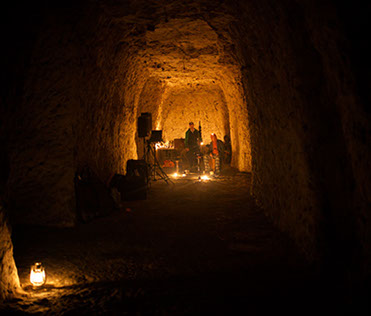
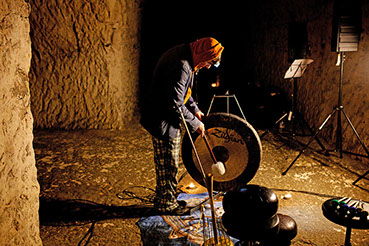
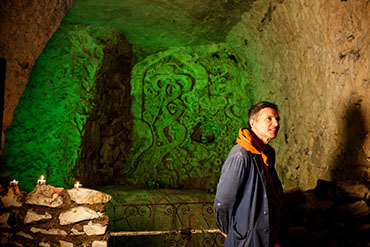
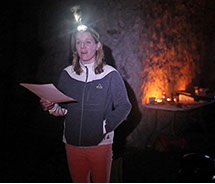
Why ?
You might be thinking ‘somebody should probably tell Rob about reverb plug-ins’. Why drag 15 people and literally a tonne of recording equipment, PA systems and delicate instruments into a cave when you could be recording in a warm, dry, well-lit studio with no danger of a bat in the hair and add reverb at your leisure?
Well, despite reverb hardware and software being very good indeed these days, I think you still can’t beat a real acoustic, and this one is special. With a network of microphone configurations positioned along the tunnels, I think we captured a sound that would be impossible to achieve any other way.
A real acoustic environment ‘feeds back’ to the musicians and makes them play their instruments to the sound (and in this case the reverb is so long you can harmonise to it). And it’s spooky as hell, which was great for getting everybody into the mood.
But probably the most creative reason is that you can use the tunnel network as a musical effect, creating a sense of building tension by changing the proximity of the musicians to the microphones by having them physically move around, or fading between different mic positions in the mix. For example, we used ‘whirly tubes’, thunder drums and a procession of what we called ‘druid percussion’ and put the players in different tunnels – some up to 100 metres away, slowly moving towards our main mics so there is a subliminal building effect as the perspective changes.
The challenge
A massive natural reverb presents several challenges when recording, and composing, so working with Andrew, I wrote very sparse, simple pieces with lots of space in them, treating the reverb as a voice in the music as it can generate its own harmonies.
We planned for the obvious problems – candles, batteries and layers of warm clothing, but we underestimated the logistical problem of working with a 30 second reverb. Every time somebody needed to enter or leave the caves we had to wait about 20 minutes while they walked down because we could hear them start their journey from about quarter of a mile away. Any time anybody spoke, dropped something or their tummy rumbled the sound went on for 30 seconds. Synchronised toilet breaks were necessary.
Accompanied by a trail of paraffin lamps so we could find our way back out, we set up camp in the "Druid" section of caves as it has the best acoustics due to the smoothness of their walls and labyrinthine layout of their tunnels. They get wider and taller and focus in to a central point (in front of an alleged sacrificial alter) which is where we had our musicians. They were such hardy professionals that hardly any of them sobbed with fear or contracted hypothermia.
The cold creates many issues – not an easy environment for musicians to play in, but the biggest issue was the damp. The mics didn’t like it at all and had to be carefully dried out over candles before they would work again.
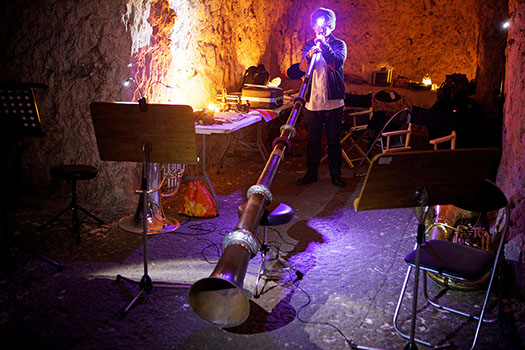
Instruments
We used a huge variety of instruments including a brass section, Bütone tank drums, waterphones, whirly tubes, milk-jugs, steel sheeting, ‘cello, kalimba, cahon, a bird whistle, auto-harp, gongs, frame drums, Tibettan bells, darabukas, ‘Suffolk Tomb Horn’, a drum kit and pre-records of bagpipes and duduk played back through a large PA system. The icing on the cake was the utterly beautiful voice of soprano Grace Davidson, known for her classical repertoir, film-score recordings (including Lord of the Rings Trilogy) and work with Max Richter.
I particularly enjoyed whacking a huge iron tank with hammers and our ‘Druid percussion’ procession of several players, slowly approaching the mics from about 100 meters down a tunnel.
It’s a recording session I will never forget and it’s been an amazing process stitching it all together to create 31 tracks, three albums and over 650 mixes and stems.
I’m very grateful indeed to everybody at Audio Network for allowing me to record my music with such fantastic musicians in this truly amazing place.
The Caves
Chislehurst Caves has an extraordinary history. Technically they’re not caves as they’re entirely man made.
The earliest records of them date back to the 13th Century. One theory is that they have separate Roman and Saxon sections, (both mined for chalk), and a Druid section, built for other purposes... We worked in the Druid section.
In the 2nd World War they were Europe’s largest Air Raid Shelter, a nightly home to 15,000 inhabitants with their own hospital, cinema, chapel, stage and full electric lighting.
They also have quite a musical history with Jimi Hendrix, The Rolling Stones, Pink Floyd and local boy David Bowie all performing there. Led Zeppelin launched their record company, Swan Song Records, with a massive cave party. They’ve also featured in film and TV including a 1972 episode of Dr Who – The Mutants, and are strongly rumoured to be haunted.
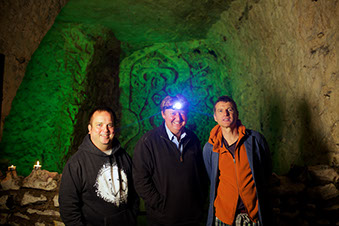
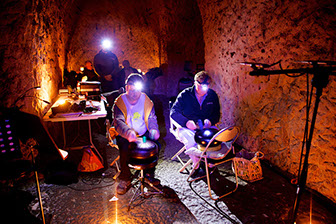
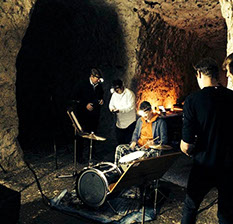
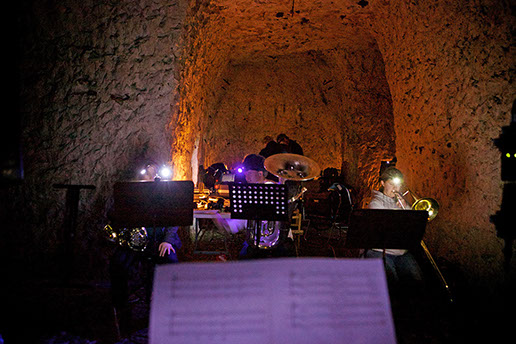
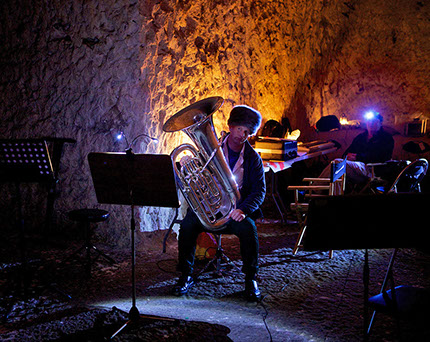
Hilbre - Short Film
I'm pleased to announce that Hilbre, a nature documentary for which I composed and recorded the score, is now released.
The film is about the wildlife on the island of Hilbre, the largest in a chain of three tidal islands that lie at the mouth of the Dee estuary, a rare outpost of wilderness in this heavily built up corner of England.
Filmed and produced by Andy Shonfelder and Alistair Dicks, this beautiful film was shot in 4K resolution using a Red Epic Digital Cinema camera with timelapse footage from Canon and Nikon SLR cameras. A high-resolution, time-lapse and slow motion specialist, Andy has worked for the BBC Natural History Unit.
The script was written in close collaboration with Matt Thomas, naturalist, blogger and columnist for several local publications. Narration is by John Curry, ex Liverpool Bay pilot, poet and author.
I wrote the music for a folk-music inspired ensemble of guitar, mandolin, clarinet, bass clarinet, 'cello, Bütone percussion and electric bass, with some sound design and textures made using an analogue synth. Clarinet and Bass Clarinet are performed by Rebecca Millward, I play all other instruments. I also mixed the sound for the film.
You can watch Hilbre in low resolution above. For further details and to watch the film in it's full quality please visit it's Vimeo on Demand page where you can download and stream it anywhere up to 4K resolution for less than the price of half a pint of beer in the Strongroom bar.